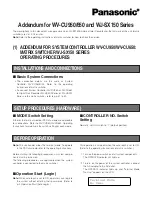
Managing QSFP Ports
169
8
Managing QSFP Ports
QSFP ports available on N4000 series switches can operate in 1 x 40G mode
or in 4 x 10G mode. Appropriate cables must be used that match the selected
mode. When changing from one mode to another, a switch reboot is required.
The QSFP ports also support stacking over the interfaces in either 1 x 40G or
4 x 10G mode. Changing from Ethernet mode to stacking mode and vice-
versa requires a reboot as well.
The ports on a QSFP plugin module are named Fo1/1/1-2 in 40-gigabit mode
and Te1/1/1-8 in 10-gigabit mode. On the N4064, the fixed QSFP ports are
named Fo1/0/1-2 in 40-gigabit mode and Te1/0/49-56 in 10-gigabit mode. All
of the possible populated or configured interfaces will show in the
show
interfaces status
command regardless of the port mode, i.e. 40-gigabit or
10-gigabit. Unpopulated or unconfigured interfaces for plug in modules do
not show in the
show interfaces status
command.
The default setting for a 40-gigabit Ethernet interface is nonstacking,
40-gigabit Ethernet (1 x 40G).
The commands to change 1 x 40G and 4 x 10G modes are always entered on
the 40-gigabit interfaces.
The commands to change the Ethernet/stack mode are entered on the
appropriate interface (tengigabitethernet or fortygigabitethernet). It is
possible to configure some of the 10G ports in a 40G interface as stacking and
not others.
To reconfigure a QSFP port, select the 40-gigabit port to change in Interface
Config mode and enter the
hardware profile portmode
command with the
selected mode. For example, to change a 1 x 40G port to 4 x 10G mode, enter
the following commands on the forty-gigabit interface:
console(config)#interface fo1/1/1
console(config-if-Fo1/1/2)#hardware profile portmode 4x10g
This command will not take effect until the switch is rebooted.
console(config-if-Fo1/1/2)#do reload
Are you sure you want to reload the stack? (y/n)
Summary of Contents for N2000 Series
Page 50: ...50 Contents ...
Page 54: ...54 Introduction ...
Page 134: ...134 Using Dell OpenManage Switch Administrator ...
Page 168: ...168 Setting Basic Network Information ...
Page 206: ...206 Managing a Switch Stack ...
Page 242: ...242 Configuring Authentication Authorization and Accounting ...
Page 318: ...318 Managing General System Settings Figure 12 24 Verify MOTD ...
Page 322: ...322 Managing General System Settings ...
Page 358: ...358 Configuring SNMP ...
Page 388: ...388 Managing Images and Files ...
Page 415: ...Monitoring Switch Traffic 415 Figure 16 2 sFlow Agent Summary ...
Page 451: ...Monitoring Switch Traffic 451 5 On the Capture Options dialog click Manage Interfaces ...
Page 458: ...458 Monitoring Switch Traffic ...
Page 488: ...488 Configuring Port Characteristics Figure 18 3 Copy Port Settings 8 Click Apply ...
Page 502: ...502 Configuring Port Characteristics ...
Page 567: ...Configuring Port and System Security 567 Figure 19 38 Captive Portal Client Status ...
Page 674: ...674 Configuring VLANs Figure 21 17 GVRP Port Parameters Table ...
Page 680: ...680 Configuring VLANs Figure 21 24 Double VLAN Port Parameter Table ...
Page 714: ...714 Configuring VLANs ...
Page 737: ...Configuring the Spanning Tree Protocol 737 Figure 22 9 Spanning Tree Global Settings ...
Page 760: ...760 Configuring the Spanning Tree Protocol ...
Page 786: ...786 Discovering Network Devices ...
Page 793: ...Configuring Port Based Traffic Control 793 Figure 24 3 Storm Control 5 Click Apply ...
Page 878: ...878 Configuring Connectivity Fault Management ...
Page 899: ...Snooping and Inspecting Traffic 899 Figure 27 17 DAI Interface Configuration Summary ...
Page 903: ...Snooping and Inspecting Traffic 903 Figure 27 24 Dynamic ARP Inspection Statistics ...
Page 924: ...924 Configuring Link Aggregation Figure 28 7 LAG Hash Summary ...
Page 982: ...982 Configuring Link Aggregation ...
Page 1062: ...1062 Configuring DHCP Server and Relay Settings ...
Page 1096: ...1096 Configuring L2 and L3 Relay Features Figure 34 3 DHCP Relay Interface Summary ...
Page 1200: ...1200 Configuring OSPF and OSPFv3 ...
Page 1216: ...1216 Configuring RIP ...
Page 1240: ...1240 Configuring VRRP ...
Page 1291: ...Configuring Differentiated Services 1291 Figure 40 5 DiffServ Class Criteria ...
Page 1336: ...1336 Configuring Auto VoIP ...
Page 1367: ...Managing IPv4 and IPv6 Multicast 1367 Figure 43 20 IGMP Cache Information ...
Page 1422: ...1422 Managing IPv4 and IPv6 Multicast ...
Page 1440: ...1440 System Process Definitions ...
Page 1460: ...Index 1460 ...
















































